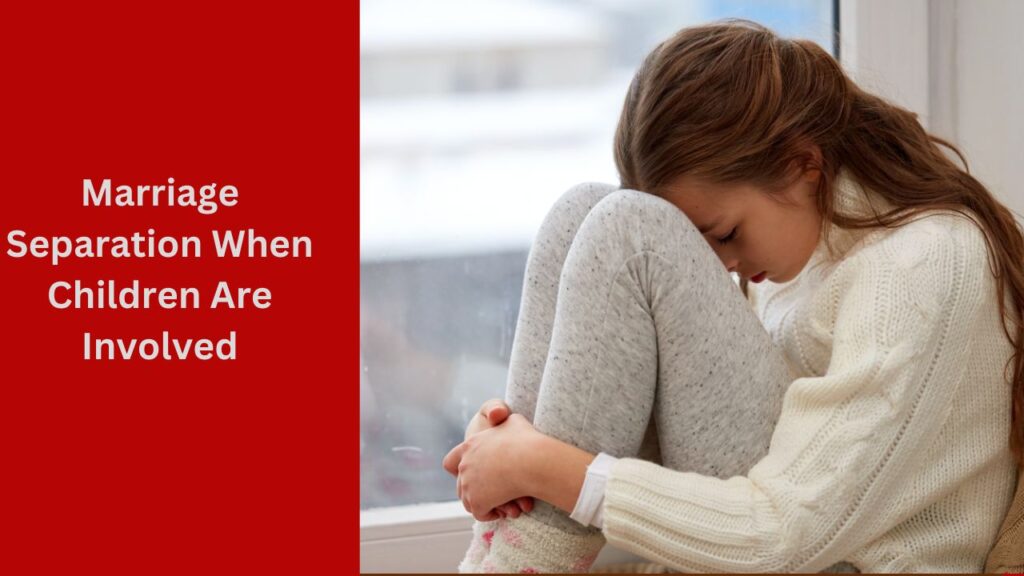
Navigating the Complexities with Care
Marriage separation or divorce is a challenging experience for all parties involved, but when children are part of the equation, the emotional and practical complexities increase significantly. Ensuring the well-being of the children should be the top priority, but this requires careful planning, clear communication, and a deep understanding of the impacts and responsibilities that come with the process.
1. Understanding the Emotional Impact on Children
1.1. The Initial Shock and Its Consequences
Children often experience a profound sense of shock when their parents separate. This disruption can lead to a wide range of emotions, including fear, confusion, anger, and sadness. Younger children might not fully understand the situation, but they can sense the tension and changes in their environment, leading to feelings of insecurity.
1.2. Long-Term Emotional Repercussions
The long-term emotional impact on children can vary depending on their age, personality, and the way the separation is handled. Some children might develop anxiety or depression, while others could struggle with feelings of abandonment or guilt. It’s crucial for parents to be aware of these potential issues and provide consistent emotional support.
2. Effective Communication: A Cornerstone for Stability
2.1. Open and Honest Communication with Children
It’s essential for parents to communicate openly and honestly with their children about the separation. Explaining the situation in age-appropriate terms helps children understand that the separation is not their fault. Reassurance about the continued love and support from both parents is key to alleviating fears and insecurities.
2.2. Co-Parenting Communication Strategies
For co-parenting to be successful, effective communication between the parents is vital. This involves discussing and agreeing on parenting decisions, schedules, and routines. Parents should strive to maintain a united front in front of their children to avoid confusion and ensure stability.
3. Legal Considerations: Custody and Support
3.1. Types of Custody Arrangements
Custody decisions are among the most critical legal aspects of separation involving children. There are various types of custody arrangements, including joint custody, sole custody, and split custody. Each arrangement has its pros and cons, and the best choice depends on the family’s specific circumstances and the child’s best interests.
3.2. Child Support: Ensuring Financial Stability
Child support is another crucial legal consideration. Ensuring that children have the financial resources they need for their education, health, and overall well-being is paramount. Child support agreements should be fair, reflecting the needs of the child and the financial capabilities of each parent.
4. Maintaining Stability: Routines and Consistency
4.1. The Importance of Routine in Children’s Lives
Children thrive on routine, and maintaining consistent daily schedules during a separation can provide a sense of security and normalcy. Keeping routines like bedtime, school schedules, and extracurricular activities unchanged as much as possible can help children adjust to the new situation.
4.2. Handling Transitions Between Homes
Transitions between homes can be stressful for children, especially if the separation is recent. Creating a predictable schedule for these transitions and preparing children in advance can ease the stress. Parents should collaborate to ensure that both homes provide a stable and nurturing environment.
5. Addressing Behavioral Changes
5.1. Recognizing Signs of Distress
Children may not always express their emotions directly, so it’s important for parents to be vigilant about changes in behavior. Signs of distress can include withdrawal from social activities, declining academic performance, changes in eating or sleeping patterns, and increased irritability.
5.2. Intervening Early with Support
Early intervention is crucial if a child is showing signs of distress. This might involve talking to the child, seeking counseling, or engaging with teachers and caregivers to monitor the child’s well-being. Professional support from a child psychologist or therapist can be invaluable in helping the child process their emotions and adjust to the new family dynamics.
6. Co-Parenting: Working Together for the Child’s Best Interest
6.1. Developing a Co-Parenting Plan
A well-thought-out co-parenting plan is essential for ensuring that both parents remain involved in their child’s life. This plan should outline how decisions will be made, how time will be shared, and how conflicts will be resolved. Flexibility and a willingness to cooperate are key to the plan’s success.
6.2. Navigating Holidays and Special Occasions
Holidays and special occasions can be particularly challenging after a separation. Parents should plan these times carefully to ensure that the child can enjoy celebrations without feeling torn between two households. It’s often helpful to establish new traditions that can be embraced in both homes.
7. The Role of Extended Family and Friends
7.1. Involving Extended Family
Extended family members can provide additional support during a separation. Grandparents, aunts, uncles, and cousins can offer stability and a sense of continuity for children. However, it’s important to set clear boundaries and ensure that extended family members respect the parenting decisions made by the child’s parents.
7.2. Encouraging Positive Social Connections
Maintaining social connections outside the immediate family is also important for children during a separation. Encouraging children to spend time with friends, participate in group activities, and maintain hobbies can provide a healthy outlet for their emotions and reduce feelings of isolation.
8. Moving Forward: Healing and Growth
8.1. Encouraging Emotional Resilience
While the separation process is difficult, it can also be an opportunity to build emotional resilience in children. By providing consistent support, encouraging open communication, and fostering a positive outlook, parents can help their children develop the coping skills they need to navigate life’s challenges.
8.2. Fostering a Positive Post-Separation Relationship
Finally, it’s important for both parents to strive toward fostering a positive relationship with their children after the separation. This means being present, showing affection, and reinforcing that the child is loved unconditionally. A positive post-separation relationship with both parents is crucial for the child’s long-term well-being.
Conclusion: Prioritizing the Child’s Well-Being
Separation is never easy, especially when children are involved. However, with careful planning, open communication, and a focus on the child’s needs, parents can navigate this challenging time while minimizing the impact on their children. By prioritizing the child’s well-being and working together, even in separate households, parents can help their children emerge from the experience stronger and more resilient.
4o
